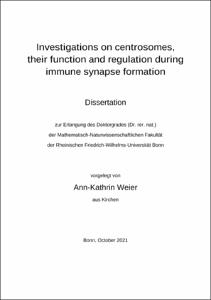Investigations on centrosomes, their function and regulation during immune synapse formation

Investigations on centrosomes, their function and regulation during immune synapse formation

| dc.contributor.advisor | Kiermaier, Eva | |
| dc.contributor.author | Weier, Ann-Kathrin | |
| dc.date.accessioned | 2022-01-24T08:11:55Z | |
| dc.date.available | 2022-01-24T08:11:55Z | |
| dc.date.issued | 24.01.2022 | |
| dc.identifier.uri | https://hdl.handle.net/20.500.11811/9563 | |
| dc.description.abstract | The centrosome is a cellular organelle well known for its function during cell division. It consists of two centrioles that are formed by microtubules and surrounded by a multiprotein matrix the so-called pericentriolar material. In G1 phase of the cell cycle one centrosome is present, which is duplicated in parallel to the DNA once the cell starts progressing through the cell cycle, leading to two centrosomes in S/G2 phase and mitosis. This duplication process is tightly controlled, ensuring correct numbers of centrosomes in each phase of the cell cycle. By nucleating microtubules, the centrosome overtakes the task of a microtubule organizing center and thus plays an important function for various interphase specific processes such as antigen presentation, migration and immune synapse formation. The immunological synapse represents a cell-cell contact zone between an antigen-presenting cell and a T cell, which is a highly specialized structure made of signaling transduction molecules and cytoskeletal components. Downstream of the immune synapse, reorientation of the centrosome takes place, once a cell-conjugate is formed. However, on the antigen-presenting cell side of the immune synapse centrosome dynamics are insufficiently understood. Therefore, we aimed to clarify microtubule organizing center conformation and how this affects immune responses. By doing so, we identified a previously unrecognized phenomenon of extra centrosomes within arrested dendritic cells. These extra centrosomes arise during the process of cell maturation after stimulation with the Toll-like receptor 4 agonist lipopolysaccharide. The phenomenon of having amplified centrosomes is a well-described characteristic of cancer cells, therefore often associated with malignancy. Only recently, cycling progenitors of olfactory sensory neurons have been identified to contain amplified centrosomes as part of normal cell development. As dendritic cells represent a critical linker between innate and adaptive immunity, we sought to investigate the physiological function of extra centrosomes in dendritic cells during immune responses. As a result, we identified two mechanisms how extra centrosomes arise: either through centriole overduplication or by an aborted cell division. Additionally, we observed a strong upregulation of polo-like kinase 2 upon maturation of dendritic cells. This protein is a central element in controlling regular centriole duplication. In polo-like kinase 2 deficient cells, centrosome numbers were significantly reduced, indicating that polo-like kinase 2 is a major driver of extra centrosome generation in dendritic cells. In the next step, we evaluated the capacity of extra centrosomes in nucleating microtubules and observed excess microtubule numbers emanating from amplified centrosomes during immune synapse formation. Furthermore, we were able to separate dendritic cells based on their centrosomal content and demonstrate that in co-culture experiments of antigen loaded dendritic cells with CD4 T cells, T cells were activated more efficiently when primed with dendritic cells carrying extra centrosomes. Secretome analysis revealed higher amounts of immune cell attracting and activating cytokines released by dendritic cells with amplified centrosomes providing a possible explanation for the observed optimized T cell response. During immune synapse formation, the centrosome(s) in dendritic cells is positioned centrally with extra centrosomes clustering in close proximity to each other. This seems to be the favoured centrosome conformation for dendritic cells, however the impact on T cell activation still needs to be clarified. In summary, we provide evidence for a beneficial physiological function of extra centrosomes within the immune compartment and further strengthen our understanding on how the immune system operates on a molecular level. Our studies provide valuable results for distinct research fields such as Cell biology, Immunology and Cancer Biology and are therefore of great value for a large scientific community. | en |
| dc.language.iso | eng | |
| dc.rights | In Copyright | |
| dc.rights.uri | http://rightsstatements.org/vocab/InC/1.0/ | |
| dc.subject | Immunologische Synapse | |
| dc.subject | dendritische Zellen | |
| dc.subject | T Zellen | |
| dc.subject | multiple Zentrosomen | |
| dc.subject | Zentriolen | |
| dc.subject | Mikrotubuli | |
| dc.subject | immune synapse | |
| dc.subject | dendritic cell | |
| dc.subject | T cell | |
| dc.subject | multiple centrosomes | |
| dc.subject | centrioles | |
| dc.subject | microtubules | |
| dc.subject.ddc | 610 Medizin, Gesundheit | |
| dc.title | Investigations on centrosomes, their function and regulation during immune synapse formation | |
| dc.type | Dissertation oder Habilitation | |
| dc.publisher.name | Universitäts- und Landesbibliothek Bonn | |
| dc.publisher.location | Bonn | |
| dc.rights.accessRights | openAccess | |
| dc.identifier.urn | https://nbn-resolving.org/urn:nbn:de:hbz:5-65226 | |
| dc.relation.doi | https://doi.org/10.21203/rs.3.rs-83155/v1 | |
| ulbbn.pubtype | Erstveröffentlichung | |
| ulbbnediss.affiliation.name | Rheinische Friedrich-Wilhelms-Universität Bonn | |
| ulbbnediss.affiliation.location | Bonn | |
| ulbbnediss.thesis.level | Dissertation | |
| ulbbnediss.dissID | 6522 | |
| ulbbnediss.date.accepted | 18.01.2022 | |
| ulbbnediss.institute | Mathematisch-Naturwissenschaftliche Fakultät : Fachgruppe Molekulare Biomedizin / Life & Medical Sciences-Institut (LIMES) | |
| ulbbnediss.fakultaet | Mathematisch-Naturwissenschaftliche Fakultät | |
| dc.contributor.coReferee | Weighardt, Heike | |
| ulbbnediss.contributor.orcid | https://orcid.org/0000-0003-2700-1102 | |
| ulbbnediss.contributor.gnd | 1252665849 |
Files in this item
This item appears in the following Collection(s)
-
E-Dissertationen (4465)




